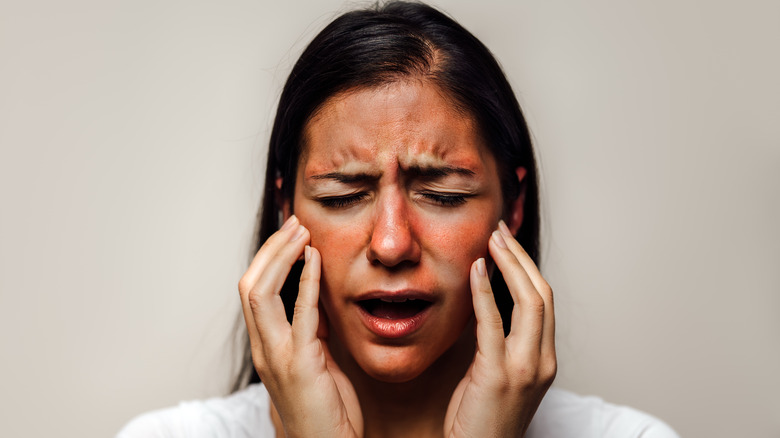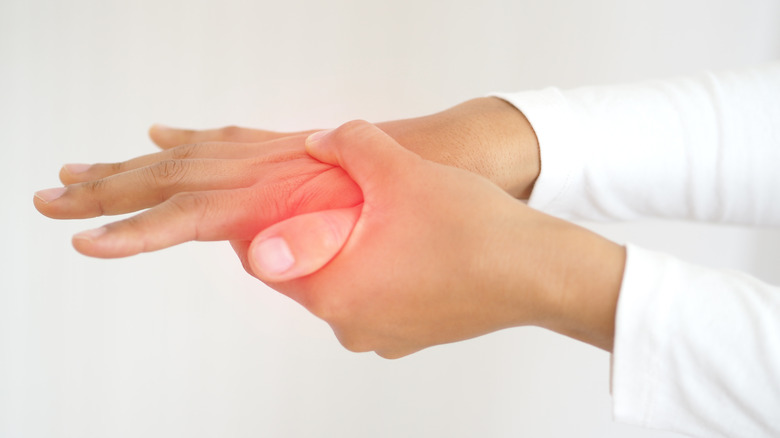Ways That Lupus Might Be Harming Your Skin
There's a good chance that you've heard about lupus due to the growing awareness of the disease. Through the World Lupus Federation, more than 200 groups have raised awareness about lupus around the world, and information about the signs and symptoms of lupus has reached approximately 839 million people, as reported by the Lupus Foundation of America. Many celebrities have used their voice as a platform to bring awareness to the disease, including Selena Gomez, who publicly disclosed her own journey with lupus in 2015.
Maybe someone you love has lupus, or maybe you have it yourself. According to the Lupus Foundation of America, it's estimated that about 1.5 million people in the United States live with lupus, with 9 out of 10 of those affected being women. Women of childbearing age are more likely to have lupus, as it usually develops between the ages of 15 and 44. Research has also found that women of color have an increased risk of developing lupus.
Lupus is a chronic autoimmune disease where the body's immune system attacks itself, as explained by the National Institute of Arthritis and Musculoskeletal and Skin Diseases (NIH). People with lupus can experience inflammation and widespread tissue damage. Symptoms of lupus are unique to each individual, but they can include fever, fatigue, hair loss, abdominal pain, and organ problems.
It's not uncommon for individuals with lupus to also develop skin rashes. The question is: How exactly does having lupus impact someone's skin?
How can lupus affect the skin?
For someone with lupus, the skin problems accompanying the disease can be frustrating. These skin problems are medically referred to as "cutaneous lupus," or "skin lupus," according to the Cleveland Clinic. Skin lupus can be found in individuals diagnosed with systemic lupus erythematosus (SLE), the most common form of lupus (per Centers for Disease Control and Prevention). Rashes and other symptoms of skin lupus may appear during times of heightened physical and emotional stress.
The most common form of skin lupus is called "discoid cutaneous lupus" (per BNJ Best Practice). The thick, scaly, and red rashes characterized by this type are round in shape. Exposure to ultraviolet (UV) light and smoking can exacerbate symptoms. When these symptoms occur, the skin can become scarred and discolored.
Rashes associated with subacute cutaneous lupus, the second form of skin lupus, commonly appear around the neck, chest, back, and arms. These rashes are shaped like rings with a dark red border and can be triggered by some medications. Pain and scarring are not typically experienced by people with subacute cutaneous lupus.
Acute cutaneous lupus, which looks like a sunburn, is the last form of skin lupus. It's known as the "butterfly rash" because of its butterfly-like shape, according to the Lupus Foundation of America. It can be found on the cheeks, the bridge of the nose, and elsewhere on the body.
Next, let's dive into how someone with skin lupus can minimize their risk of long-term skin damage.
How can you minimize the effects of lupus on the skin?
Living with lupus is stressful enough, and experiencing skin rashes and lesions can make someone feel even more insecure. According to NYU Langone Health, someone with skin lupus can find the appropriate treatment with the help of a dermatologist. They will examine the patient's skin to gauge the severity of their symptoms, as they can fluctuate over time.
Someone with skin lupus will likely be advised by their doctor to avoid sunlight since ultraviolet (UV) light can trigger an increase in symptoms. NYU Langone Health dermatologists recommend staying indoors between 10:00 a.m. and 4:00 p.m., which is when the sun's rays are at their peak. For times when it's impossible to avoid being out in the sun, wearing sunscreen is imperative. Whenever they are exposed to sunlight, individuals with skin lupus should wear broad-spectrum sunscreen with an SPF of at least 30 to minimize skin damage.
Medications can also be utilized to treat skin lupus. In order to relieve uncomfortable symptoms, corticosteroid medications can be used in cream, gel, or injection form. Additionally, oral antimalarial medications can be taken long-term. People who take corticosteroid medications or antimalarial medications may notice improvements in the condition of their skin, as redness, burning, and swelling is alleviated. It's also possible to treat skin lupus with laser therapy in some cases (per American Academy of Dermatology Association).
Those who are struggling with symptoms of skin lupus should discuss their treatment options with a dermatologist.



